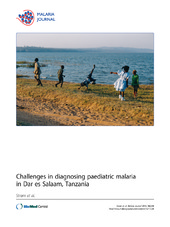| dc.description.abstract | Background: Malaria is a major cause of paediatric morbidity and mortality. As no clinical features clearly differentiate malaria from other febrile illnesses, and malaria diagnosis is challenged by often lacking laboratory equipment and expertise, overdiagnosis and overtreatment is common. Methods: Children admitted with fever at the general paediatric wards at Muhimbili National Hospital (MNH), Dar es Salaam, Tanzania from January to June 2009 were recruited consecutively and prospectively. Demographic and clinical features were registered. Routine thick blood smear microscopy at MNH was compared to results of subsequent thin blood smear microscopy, and rapid diagnostics tests (RDTs). Genus-specific PCR of Plasmodium mitochondrial DNA was performed on DNA extracted from whole blood and species-specific PCR was done on positive samples. Results: Among 304 included children, 62.6% had received anti-malarials during the last four weeks prior to admission and 65.1% during the hospital stay. Routine thick blood smears, research blood smears, PCR and RDT detected malaria in 13.2%, 6.6%, 25.0% and 13.5%, respectively. Positive routine microscopy was confirmed in only 43% (17/40), 45% (18/40) and 53% (21/40), by research microscopy, RDTs and PCR, respectively. Eighteen percent (56/304) had positive PCR but negative research microscopy. Reported low parasitaemia on routine microscopy was associated with negative research blood slide and PCR. RDT-positive cases were associated with signs of severe malaria. Palmar pallor, low haemoglobin and low platelet count were significantly associated with positive PCR, research microscopy and RDT. Conclusions: The true morbidity attributable to malaria in the study population remains uncertain due to the discrepancies in results among the diagnostic methods. The current routine microscopy appears to result in overdiagnosis of malaria and, consequently, overuse of anti-malarials. Conversely, children with a false positive malaria diagnosis may die because they do not receive treatment for the true cause of their illness. RDTs appear to have the potential to improve routine diagnostics, but the clinical implication of the many RDT-negative, PCR-positive samples needs to be elucidated. | en_US |

